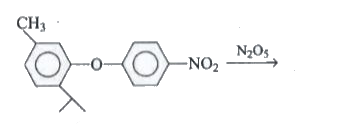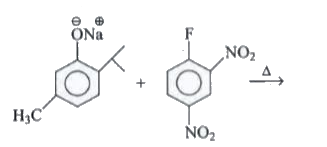Which is the best leaving group ?
−⊕N≡N
OH−
NH−2
CH3COO−
The correct Answer is:A
To determine which is the best leaving group among the given options, we need to analyze the stability of the leaving groups after they depart from the substrate. A better leaving group is one that forms a more stable species after leaving.
1. Identify the Leaving Groups: The options provided are:
- A) N2+
- B) OH−
- C) NH2−
- D) CH3COO−
2. Analyze Each Leaving Group:
- Option A: N2+ (Nitrogen gas): When N2+ leaves, it forms a neutral nitrogen gas (N2), which is very stable and inert. The departure of N2+ does not leave any charge, making it a very favorable leaving group.
- Option B: OH− (Hydroxide ion): When OH− leaves, it forms a negatively charged hydroxide ion. The negative charge on OH− is not stabilized by any electron-withdrawing groups, making it a less favorable leaving group compared to N2+.
- Option C: NH2− (Amide ion): Similar to OH−, when NH2− leaves, it also forms a negatively charged amide ion. The negative charge on NH2− is not stabilized, making it a poor leaving group.
- Option D: CH3COO− (Acetate ion): When CH3COO− leaves, it forms a negatively charged acetate ion. However, the acetate ion is resonance-stabilized, which makes it a better leaving group than OH− and NH2−, but still not as good as N2+.
3. Compare the Stability of the Leaving Groups:
- N2+ forms a stable, neutral gas.
- OH− and NH2− both leave as negatively charged ions that are not stabilized.
- CH3COO− is stabilized by resonance, but still carries a negative charge.
4. Conclusion: Since N2+ leaves as a neutral and stable molecule, it is the best leaving group among the options provided.
Final Answer:
The best leaving group is Option A: N2+.
---
- A) N2+
- B) OH−
- C) NH2−
- D) CH3COO−
- Option A: N2+ (Nitrogen gas): When N2+ leaves, it forms a neutral nitrogen gas (N2), which is very stable and inert. The departure of N2+ does not leave any charge, making it a very favorable leaving group.
- Option B: OH− (Hydroxide ion): When OH− leaves, it forms a negatively charged hydroxide ion. The negative charge on OH− is not stabilized by any electron-withdrawing groups, making it a less favorable leaving group compared to N2+.
- Option C: NH2− (Amide ion): Similar to OH−, when NH2− leaves, it also forms a negatively charged amide ion. The negative charge on NH2− is not stabilized, making it a poor leaving group.
- Option D: CH3COO− (Acetate ion): When CH3COO− leaves, it forms a negatively charged acetate ion. However, the acetate ion is resonance-stabilized, which makes it a better leaving group than OH− and NH2−, but still not as good as N2+.
- N2+ forms a stable, neutral gas.
- OH− and NH2− both leave as negatively charged ions that are not stabilized.
- CH3COO− is stabilized by resonance, but still carries a negative charge.
The best leaving group is Option A: N2+.
Similar Questions
Nucleophilic substitution reactions generally expressed as
Nu−+R−L→R−Nu+L−
Where Nu−→ Nucleophile , R−L→ substrate, L→ leaving group
The best leaving groups are those that become the most stable ions after they depart. since most leaving group leave as a negatibe ion, the best leaving groups are those ions that stabilize a negative charge most effectively. A good leaving group should be
(a) electron-withdrawing to polarize the carbon
(b) stable once it has left (not a strong base)
(c) polaristable to maintain partial bonding with the carbon in the transition state (both SN1 and SN2). This bonding helps to stabilise the transition state and reduces the activation energy.
(I) CI− (II) CH3O− (III) CH3S− (IV) I−
The correct order of increasing leaving group capability of above anions
View SolutionNucleophilic substitution reactions generally expressed as
Nu−+R−L→R−Nu+L−
Where Nu−→ Nucleophile , R−L→ substrate, L→ leaving group
The best leaving groups are those that become the most stable ions after they depart. since most leaving group leave as a negatibe ion, the best leaving groups are those ions that stabilize a negative charge most effectively. A good leaving group should be
(a) electron-withdrawing to polarize the carbon
(b) stable once it has left (not a strong base)
(c) polaristable to maintain partial bonding with the carbon in the transition state (both SN1 and SN2). This bonding helps to stabilise the transition state and reduces the activation energy.
Among the following which is feasible?
View Solution
Knowledge Check
Which is the best synthesis of
 A
A B
B C
C Dall are incorrect
Dall are incorrectWhich is the best definition of active transport?
AMovement of molecules from an area of their higher concentration to an area of their lower concentrationBMovement of water across a semi-permeable membrane from an area of high water concentration to an area of lower water concentrationCMovement of molecules from an area of their lower concentration to an area of their higher concentrationDMovement of a substance against its concentration through the release of energy from ATP
Nucleophilic substitution reactions generally expressed as
Nu−+R−L→R−Nu+L−
Where Nu−→ Nucleophile , R−L→ substrate, L→ leaving group
The best leaving groups are those that become the most stable ions after they depart. since most leaving group leave as a negatibe ion, the best leaving groups are those ions that stabilize a negative charge most effectively. A good leaving group should be
(a) electron-withdrawing to polarize the carbon
(b) stable once it has left (not a strong base)
(c) polaristable to maintain partial bonding with the carbon in the transition state (both SN1 and SN2). This bonding helps to stabilise the transition state and reduces the activation energy.
Among the following which is false statement?
View SolutionNucleophilic substitution reactions generally expressed as
Nu−+R−L→R−Nu+L−
Where Nu−→ Nucleophile , R−L→ substrate, L→ leaving group
The best leaving groups are those that become the most stable ions after they depart. since most leaving group leave as a negatibe ion, the best leaving groups are those ions that stabilize a negative charge most effectively. A good leaving group should be
(a) electron-withdrawing to polarize the carbon
(b) stable once it has left (not a strong base)
(c) polaristable to maintain partial bonding with the carbon in the transition state (both SN1 and SN2). This bonding helps to stabilise the transition state and reduces the activation energy.
(I) CH3Br (II) CH3F (III) CH3OH (IV) CH3OSO2CF3
The correct order of decreasing reactivity of the above compounds towards CH3O− in an SN2 reaction is:
View SolutionIn which of the following options chlorine will acts as the best leaving group.
View SolutionWhich is the best definition of birds?
View SolutionWhich is the best combination of regent for the reaction

View SolutionRSӨ is a stronger nucleophile and a better leaving group than ROӨ.
RSӨ is a weaker base than RSӨ.
View Solution
